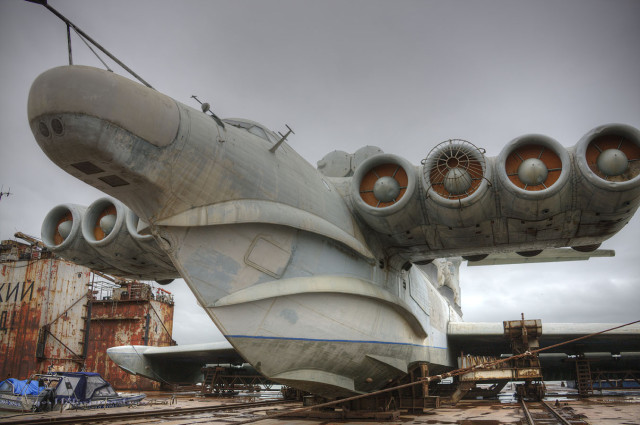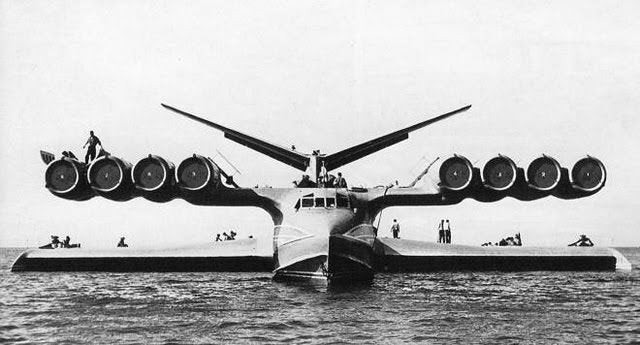The Russian’s never fail to impress with their wacky inventions designed to wreak havoc on the modern battlefield. From automatic, 50. caliber, handheld machine guns like the 6P62 and the ASh-12.7 to the SS-18 Satan Missile, Russian weapons are pretty intense. However, it was back in the Soviet Union that one of Russia’s scariest and bizarre weapons hit the global stage: The Caspian Sea Monster. This Ekranoplan Model plane appeared in the 1960s and became an interesting feature of the Cold War. Its aesthetic is too good to miss, so we’re going to give you the Soviet Wastelands lowdown on this fascinating aircraft.
Back in the 1960s, as the Cold War was in full motion, the Soviet Union began to develop an intense interest in a variety of new weapons to use in the expected global war with the USA and the West. In particular, the Soviets started looking into what is known as Ekranoplan or ground effect vehicles. Ekranoplan utilizes the lift generated by the ground effect of its large wings when within around 13 ft above the surface they are flying over. Despite the fact that they look alarmingly similar to normal aircraft and share many of the same characteristics, ekranoplans are not aircraft, seaplanes, hovercraft, nor hydrofoils. They are classed as ships by the International Maritime Organization.

The Soviets set up what became known as the Central Hydrofoil Design Bureau and began constructing their Ekranoplan. In 1966, the first beast of this design rolled out of a secret production plant in the city of Nizhny Novgorod. Codenamed the Korabl Maket which translates to Ship-prototype, it had a wingspan of 123 feet and was over 300 feet long. Its payload ability of 544 tons combined with its size was breathtaking made it, at the time, the largest aircraft on the planet and would soon go on to be nicknamed the Caspian Sea Monster due to the sea being the main training location for the plane.
True to the Ekranoplan design, the Caspian Sea Monster was able to fly between 16 and 33 feet above surfaces using the ground effect technology. This low altitude also made it impossible to detect on radar. Despite looking overwhelmingly like a plane, the new creation was placed under the authorities of the Soviet Navy but was operated by pilots from the Soviet Air Force. This in itself was likely a Soviet Ruse to create mystery around the secret weapon. On its first flight, it was treated as a boat when a bottle of Soviet champagne was smashed against its nose as was the tradition with boats. Go figure.
The first flight took place in the winter of ’66. The new weapon was sent South to the Caspian Sea and was transported down the mighty river Volga. Naturally, it was a very secret affair. The Caspian Sea Monster was completely covered in thick camouflage netting and was moved under the cover of darkness. Surprisingly, the first test flight was carried out by the actual designers of the Ekranoplan, two men named Rostislav Alexeyev and V. Efimov, a method which was largely unheard of during the Soviet Union. The weapon performed well in the initial tests. It boasted a fuel-efficient speed of 232 knots or 267 mph. Its top speed was an astounding 400 knots or 460 mph.

Despite a positive beginning, the weapon was soon being eyed for use by the Soviet military and emergency services. However, testing of the vehicle on the Caspian Sea soon dragged on throughout the 1970s as any progress slowed down significantly when the designers were tasked with other projects. In 1980, this magnificent invention crashed and sank during another testing session on the Caspian. Thankfully nobody died, but following the ekranoplan crash, it was deemed too heavy to recover from the seabed and the Soviets subsequently abandoned it. Today, the Caspian sea monster wreck still lies where it crashed and remains the second-largest aircraft ever built, after the Antonov An-225 which came along eight years after the ekranoplan crash.
Despite their efforts to keep the biggest plane on earth a secret at the time, the Soviets failed. Those pesky American adversaries uncovered the project via a spy satellite in 1967. The US spotted the ekranoplan when it was taxying at a Soviet military base in a town in Dagestan, on the Caspian sea. Naturally, the CIA and other Western intelligence agencies developed an intense interest and concern in this new enemy design. The short, stumpy wings combined with a hulking body only served to puzzle those observing the aircraft.
When it was spotted that the ekranoplan was marked with KM (Korabl-maket) and a Soviet Naval ensign on its body, the CIA developed the nickname “Kaspian Monster” which soon turned into the “Caspian Sea Monster”. Interest in the development of ground effect vehicles was not as intense in the USA as it was in the Soviet Union. In response to the ekranoplan, the US placed a task force on the case before developing one of the first unmanned aerial vehicles in the form of Project Aqualine, in order to find out just what the hell it was.

At first, the CIA assumed that the Caspian Sea Monster was an unfinished commercial aircraft. By the time they figured out that it was a large ekranoplan, the Caspian Sea Monster was already destroyed and lying in a watery grave. Following the crash of the first ekranoplan, the Central Hydrofoil Design Bureau designed the Lun-class ekranoplan, which was based on the Caspian Sea Monster. Following the collapse of the Soviet Union, the Lun-class saw continued use with the Russian Navy well into the late 1990s before finally being decommissioned.
Upon seeing a Caspian sea map one day, I became curious about the Caspian sea monster wreck and set out to see if it could be seen via satellite as the CIA did all those years ago. I opened my laptop to find the Caspian sea monster on google earth and after sifting through grainy images of UFOs and other madness supposedly lying at the bottom of the Caspian, I couldn’t find anything.
However, I did find this epic video of an ekranoplan in action. A truly terrifying machine. Picture yourself as a humble fisherman out on the Caspian Sea only to see this thing coming towards you at 460 mph!
If you enjoyed this article, be sure to check out our range of other blogs focusing on the wacky inventions of the USSR that we’ve discovered whilst traveling throughout the region. To visit the badlands of the former Soviet Union and experience flights in original Soviet aircraft, contact us to arrange a dream trip!

